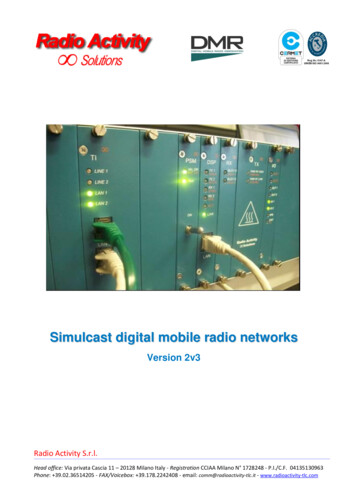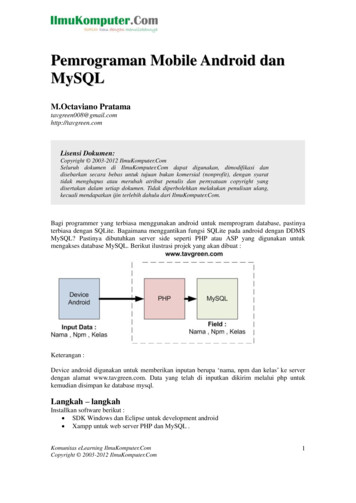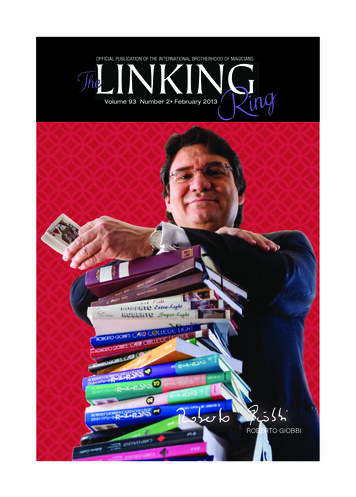
Transcription
Simulcast digital mobile radio networksVersion 2v3Radio Activity S.r.l.Head office: Via privata Cascia 11 – 20128 Milano Italy - Registration CCIAA Milano N 1728248 - P.I./C.F. 04135130963Phone: 39.02.36514205 - FAX/Voicebox: 39.178.2242408 - email: comm@radioactivity-tlc.it - www.radioactivity-tlc.com
Simulcast digital mobile radio networksdate 05/05/2017SummaryIntroduction on DMR multisite system . 4About Radio Activity . 4Digital mobile radio (DMR) in brief . 4Multisite DMR systems – Multicast/Simulcast . 7Multisite multi frequency approach .7Multisite Simulcast approach .8Simulcast solution - Expandability .10Forget the past experiences of trouble simulcast . 11Main caracteristics of Radio Activity Simulcast solutions . 12RA-XXX base stations family . 12Soft radio to soft diversity reception . 12LINUX core . 13IP native . 13Maximum system resiliency and redundancy. 14Powerful remote control . 14Designed to simplify operations . 15Full algorithms inclusive . 15National wide system solutions . 15Dispatching Center .17Understanding Simulcast basis . 19System key elements . 19To debunk urban legends about simulcast . 19Conclusions . 20Radio Activity Simulcast solutions . 21Introduction . 21Built-in simulcast oriented algorithms . 21Matching and self alignaments .21Equalization .22Voting system .22Synchronisms .23Network families . 25Page 2 of 51Version 2v3All rights reserved
Simulcast digital mobile radio networksdate 05/05/2017IP based network .25Narrowband RF linked network .27Mixed RF/IP network .27Network Configurations . 29IP based network . 29basic functioning description .29Network redundancy .30IP backbone and bandwidth requirements .31Base stations configuration .35Narrowband RF linked network. 36UHF linked Slave station .38UHF linked Master Station .38UHF linked Sub-Master station .39Remote control . 41Introduction . 41Peripheral device . 41TRX programmable parameters .42Remotely checkable radio parameters .42Transceiver self-test.43Calibration signals .43Remotely checkable lines parameters .44lines programmable parameters .44IP backbone interfaces.44Software down-loading .45Remote control connections . 45Remote control through the IP backbone .46Remote control through internal (GSM) or external modem .46Supervision SW packages . 47Factory remote assistance. 50International directives compliance . 51Page 3 of 51Version 2v3All rights reserved
Simulcast digital mobile radio networksdate 05/05/2017INTRODUCTION ON DMR MULTISITE SYSTEMABOUT RADIO ACTIVITYRadio Activity is a young and dynamic electronic engineering company specialized on design andproduction of wired and wireless communication equipments and systems.The engineering team has completed more than 20 years of experience in RF, DSP and networking atmajor telecommunications companies. Radio Activity has developed advanced techniques for analogand digital simulcast mobile radio networks and numerous products for data transmission andcommunications management.Radio Activity is a node of a network of excellence’s partners. The research and the developmentcarried out inside the Company involves Radio Frequency, Digital Signal Processing and IP networkingfields. The Company, taking advantage of external professionals of highest level with multidisciplinaryskills, is able to create, each time, work groups in order to solve the most complex projects and tosatisfy the most demanding Customer’s requirement. The result is a flexible and light structure, toreduce the fixed costs and to allow to always take advantage of the best available technology.Radio Activity in few years has furnished more than 1500 base stations for emergency and essentialservices applications to a number of important Customers: Agip, Wind, Enel, Edison, Fire Brigades,Police, Motorways, Railway, Civil Protection, Rätia Energie AG, RWE, etc.DIGITAL MOBILE RADIO (DMR) IN BRIEFDMR standard (ETSI TS 102 361/2/3) has been defined in ETSI environment, by a working groupcomposed by main PMR equipment manufacturers worldwide.Digital Mobile Radio is able to give “added value” to current analog systems and at the same time itgrants a gradual migration between the two technologies, safeguarding investments and specificexisting operational requirements. DMR system can coexist with conventional analog systems onadjacent channels, without any performance loss of each of pressedaudioC C C C C C C CH H H H H H H H1 2 1 2 1 2 1 2TempoA/DaudioDigitizedaudioAudio signal is is converted todigital format, compressed andthen "packed" in the digitaltransmission channelThe digital transmitter is activatedduring the timeslots allocated tothe working channelFrequency modulation has constant envelope (unlike the TETRA which does not have a constantenvelope). Transmitters are very similar to their traditional analog version, because expensivePage 4 of 51Version 2v3All rights reserved
Simulcast digital mobile radio networksdate 05/05/2017linearization techniques are not needed: theycan work in saturation (clipping) mode (C classo superior) with very low consumption solarpanels can be used.12.5KHz30msDMR standard performs the transportation ofboth data and voice. Audio signal is convertedinto digital format, compressed, “packed” intodigital transportation channel, differently“marked” than the data digital signal.CH3CH1CH4CH27.5KHzC C C C C C C CH H H H H H H H1 2 1 2 1 2 1 27.5KHzTwo contemporaryand indipendentcommunications onthe same frequencycarrierTimeAudio/data channels are managed with twoTDMA (Time Division Multiple Access)timeslots sharing the same radio 12.5 KHz widechannel. The two audio/data channel are perfectly separated and independent each from the other, asif they worked in a conventional mode on different frequency (carriers). The transmitter becomesactive only during timeslots belonging to their working channel.DMR system can live together with conventional analog systems on adjacent channels without anyperformance degradation for both ones. DMR system has a spectral efficiency of 1CH/6.25KHz, thesame as TETRA and double incomparison with conventional systems.QualityAnalogDMRArea of greaterbenefit of DMR20dB SINAD12dB SINADRF field / distanceOnly one radio head (only onetransmitter) gives 2 CH without the needof RF coupling systems, with the effectof lower costs and consumptions andgreater available power. Furthermore,DMR system allows the directcommunications between terminals. Inthis case only one channel per 12.5KHzwill be available because thesynchronization is missing, made by repeater/network.The sensitivity of a DMR receiver is about the same as the one of a traditional analog system, but theaudio quality remain constant up to the sensitivity limit and the coverage is slightly bigger than 12.5KHz analog systems.DMR terminals can work in “open channel” mode like traditional systems for emergencies, butindividual calls and group calls are available: obviously selective callings are addressed in a digitalformat between DMR equipment. Network accessCanale a12.5KHzof DMR terminals is regulated by a “colour code”which replaces sub-tone sub-audio tone.TS2The Radio Activity base stations are “multiprotocol” analog/digital with the automatic switchbetween the analog/DMR services. This reduces themigration impact: the old analog terminals mayoperate with the new digital one through the samenetwork.When an analog terminal accesses to the network,the other analog terminals listen him (obvious) andPage 5 of 51Version 2v3FMTS1UHF/ AnalogicoUHF /DMRCH2UHF /DMRCH1All rights reserved
Simulcast digital mobile radio networksdate 05/05/2017also the DRM terminals can listen the communication in the analog mode channel. For interoperability Analog/DMR, it is necessary to set a sub-audio tones squelch on the receiver of theterminals (it stops the noise in case of DMR signaling into the analog receivers).When a DMR terminal accesses the network using the Slot 1 or 2, the other DMR terminals can hearhim and the analog terminals don’t listen noise. Our network/repeater switches automaticallyDMR/Analog mode according to the terminal access mode.We suggest to set-up the DMR terminals with scanning functions on two channels with the samefrequency but one as analog and the other as DMR. In this case both analog and DMR incomingcommunications are listened.The DMR terminals may implement a GPS based positioning system. The channel resources of thenetwork could be used both to carry out voice and GPS positioning data. For best overall performanceit is suggestible to use one channel (timeslot 1) for dispatching voice and the second (timeslot 2) forGPS positioning and for sporadic telephone communication.The DMR standard allow many features for the user: to make a private (user to user) or a group (user to multi-user) or an “all call” (all userinvolved) or an emergency communication to assign more than 16 millions of terminal identification addresses to compose more than 16 millions of terminal groups to send/receive text messages or “raw data” for telemetry applications to send positioning data automatically to be included in a running communication (late entry) to identify the ID source and ID destination of any communication to encrypt audio and data and a lot more To differentiate adjacent networks operating on the same frequency it is required a color code accesskey that could be viewed similar to the sub-audio tone coded squelch used in analog.Radio Activity tested successfully the DMR protocol compatibility with Motorola Mototrbo TMterminals.To learn more about DMR standard we suggest to see: the latest edition of ETSI documents:o ETSI TS 102 361-1: the DMR air interface protocolo ETSI TS 102 361-2: the DMR voice and generic services and facilitieso ETSI TS 102 361-3: the DMR data protocolo ETSI TS 102 361-4: the DMR Trunking protocolo ETSI TR 102 398: DMR General System Design the latest edition of the documents on Radio Activity web site:o ENV1 - DMR overviewo ENB20 - DMR repeaterPage 6 of 51Version 2v3All rights reserved
Simulcast digital mobile radio networksdate 05/05/2017o ENB23 - DMR FAQso ENB26 - DMR vs TETRA comparisono ENB29 - Alarm Messageso ENB33 - Soft diversity reception The “white papers” on the web site of the DMR Association.MULTISITE DMR SYSTEMS – MULTICAST/SIMULCASTThe digital mobile radio (DMR) standard appears very attractive for the professional mobile radioapplications. It is a powerful digital solution that meets the major needs of users: digital encryption,good and constant audio quality, reliable data, GPS positioning without any disturb in audio, textmessaging, telemetry, two TDMA channels in 12.5KHz (6.25KHz/ch equivalent), soft migration fromanalog to digital, low power consumption, etc.DMR has all the advantages of a digital radio at the cost of an analog (conventional) one. Thesebenefits may be partially missed when the coverage requested by the radio system exceeds onerepeater. Some “key points” have to be understood to design an affordable, stable and user-friendlyradio system.The multisite system approach allows a radio to be in coverage area changing position and toparticipate in a call originating at any site. In multisite system configuration, repeaters communicateamong themselves using a back-end network. A call originating at a repeater is transmitted by all therepeaters of the system.Currently (2010) there isn’t any manufacturer able to supply a DMR trunking system following the ETSIstandard. The solutions available to cover a wide area with more than one repeater may be multicastor simulcast.To learn more about DMR multisite solutions we suggest to see: the latest edition of the documents on Radio Activity web site:o ENB25 - DMR multisite sys designo ENV2 - TCP-IP simulcastMULTISITE MULTI FREQUENCY APPROACHDesired systemcoverage areaMMasterbase stationf2f1SSSSlavebase stationf5Overlap areaMSSf4f3Single site cellcoverageBackbone linksbetween base stationsIn multicast approach, the geographically adjacent repeaters should use different frequencies. Theircolor code can be either same or different. It is not advisable to keep the same frequencies because inareas of overlap, without special precautions (see simulcast paragraph), there will be destructiveinterference.Page 7 of 51Version 2v3All rights reserved
Simulcast digital mobile radio networksdate 05/05/2
Simulcast digital mobile radio networks date 05/05/2017 Page 3 of 51











